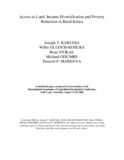Resource information
he increasing land scarcity and the worsening trend of poverty in Kenya in recent years have raised concerns about the focus on land-based agriculture as the basis of growth in the rural areas. This paper combines two complementary data sets obtained from two locations in Kenya, drawn against distinctively different land availability patterns, to examine the diverse rural asset base and key sources of livelihood in the rural areas. The analysis reveals that while access to productive land is still an important determinant of livelihoods in the rural areas, even where land holdings are very small, growth in farm productivity alone may not guarantee households sufficient incomes to escape poverty. We find evidence to suggest that growth of non-farm sector is necessary and may be much more important in reducing risks and vulnerability to poverty and should be equally emphasized if households in such regions are to escape poverty. Off-farm earnings accounted for at least 50 percent of total household incomes in the two research locations. The study further revealed existence of significant barriers to entry to remunerative livelihoods both at farm and off-farm level. The study advocates for expansion of educational services, infrastructure and strengthening of rural institutions to spur broad-based development in the rural areas.


